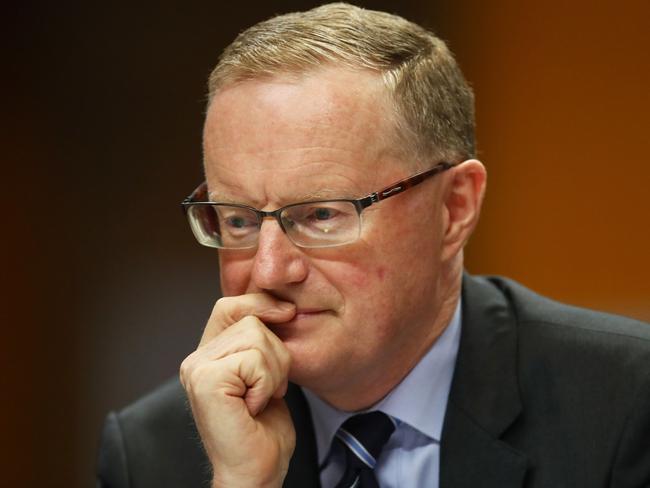Inflation railroads Jim Chalmers’ agenda as RBA ponders double hit on rates
Jim Chalmers says budget repair ahead of more spending on Medicare, defence and aged-care will drive his plans, but inflation is the ‘main focus’.

Jim Chalmers says “repairing the budget” to make way for more spending on Medicare and defence and boosting pay for aged-care workers will drive his economic plans for the year, but not adding to runaway inflation will have to remain the government’s “main focus”.
The Treasurer’s comments come as the Reserve Bank board prepares to consider whether it needs to pile further pain on borrowers with a double rate hike on Tuesday to get ahead of “uncomfortably hot” consumer price growth.
In a speech to the Chifley Research Centre laying out the Albanese government’s ambitious economic agenda, Dr Chalmers declared that the “major priority” in the upcoming budget would be “providing cost-of-living relief without adding to inflation, growing the economy in a more inclusive and more sustainable fashion, and repairing our budget so that we can fund what we really value and really cherish as a country”.
“And by that I mean strengthening Medicare, better pay and higher standards of aged care, bolstering our national security, combating entrenched disadvantage, taking some of the sting out of these high electricity bills, and most importantly of all, creating more life chances for more people in more parts of our country,” he told the Labor Party think-tank on Sunday.
“It’s possible, I believe, to maintain a focus on the pressures that people are feeling right now, at the same time as we advance a really big economic agenda this year, and still sketch out a framework for the future, all at the same time.”

Those pressures facing 3.3 million mortgaged households look set to intensify, with a ninth consecutive rate rise to 3.35 per cent now seen as virtually guaranteed, alongside the threat of an even bigger hit at the RBA’s first board meeting of the year.
Official data released last month showed inflation ended the year at 7.8 per cent in the year to December, against 7.3 per cent in September. The RBA’s preferred underlying measure of consumer price growth, which takes out more volatile items, jumped to 6.9 per cent – well above the 6.5 per cent level anticipated by the central bank’s economists.
The central bank on Tuesday will reveal an updated set of forecasts, potentially showing inflation will not reach the top of the 2-3 per cent target range for more than two years, according to ANZ estimates.
With inflationary pressures broadbased and a more resilient than anticipated economy here and abroad, Judo Bank economic adviser Warren Hogan said RBA governor Philip Lowe needed to move more aggressively or risk falling behind the curve.
“I think he (Dr Lowe) has got to go 50 basis points” – increase the cash rate by half a percentage point to 3.6 per cent – Mr Hogan said. He said a half a percentage point increase to 3.6 per cent on Tuesday could alleviate the need to go even harder later this year.
“He has got to get to 4 per cent, and get there quick smart. Other central banks are nudging 5 per cent. They (the central board) will be seriously talking 50 basis points at this week’s meeting, and about hiking 75-100 (basis points) in the next four months,” he said.
“The tone will shift.”
The RBA board has made it clear in recent board minutes that its decisions would guided by the economic data, that monetary policy was not on a “preset path”, but that it “expects to increase interest rates further over the period ahead”.
More than 800,000 households are due to experience a major bill shock this year as ultra-low fixed rate mortgages revert to much higher variable rates.
Against that, households have massive cash piles accumulated through the pandemic to offset the hit to their budgets.
“None of us really know how the economy is going to respond to these rate hikes,” Mr Hogan said. “But the policy mistake by getting behind inflation and ultimately having to put the economy into a much deeper recession in 2024 and 2025 is much bigger than tightening by 25 or 50 (basis points) too much.”
In a new report, economists at Bank of America said “given the uncomfortably hot (December quarter) CPI report, we see the likelihood of a 50bp hike as much higher than the risk of a pause at (this week’s) RBA meeting”.
But the BoA analysts agreed with the consensus view that the RBA would deliver a ninth straight rate hike of 0.25ppts on Tuesday.
ANZ senior economist Catherine Birch said the RBA in its statement on Tuesday afternoon would release updated forecasts that would show inflation not returning to the top of the 2-3 per cent target range until the second quarter of 2025.
Ms Birch said while a business-as-usual 0.25ppt hike was “the most likely option” amid early signs of a retail spending slowdown and softening business conditions, she expected the board “to consider a 50bp hike, as it has done since it moved to 25bp hikes last October”.
Leading into Monday, financial markets were pricing in at least two more hikes, and potentially three, over coming months.
Barrenjoey chief economist Jo Masters said she was “worried about the stickiness of inflation”, although she still believed that consumer price growth had peaked in the December quarter.
“Inflation will go lower – the question is, how much lower?” Ms Masters said. “Getting from 8 per cent (inflation) down to 4 or 4½ should be easy, but going from 4½ to 3 will prove really hard.”
“That plays into the rigidities of our wage-setting system. It helped (contained a rapid lift in wages growth) on the way up, but it will also work the other way on the way down.”
With inflation still expected to be high – if lower – over the start of this year, Ms Masters said the minimum wage decision this year looked likely to deliver an increase in the order of 6 per cent, after last year’s 5.4 per cent lift.
“The Fair Work Commission will only have the first quarter of inflation data when it makes its decision, and the commission has never delivered a national minimum wage increase that is less than core inflation,” she said.
Ms Masters said she was keeping her call for a further two 0.25ppt rate hikes at this and the next month’s meetings, before a pause at 3.6 per cent.
“Before the recent CPI figures we didn’t have much conviction in the March move, but now we’re comfortable with the view we have,” Ms Masters said.




To join the conversation, please log in. Don't have an account? Register
Join the conversation, you are commenting as Logout